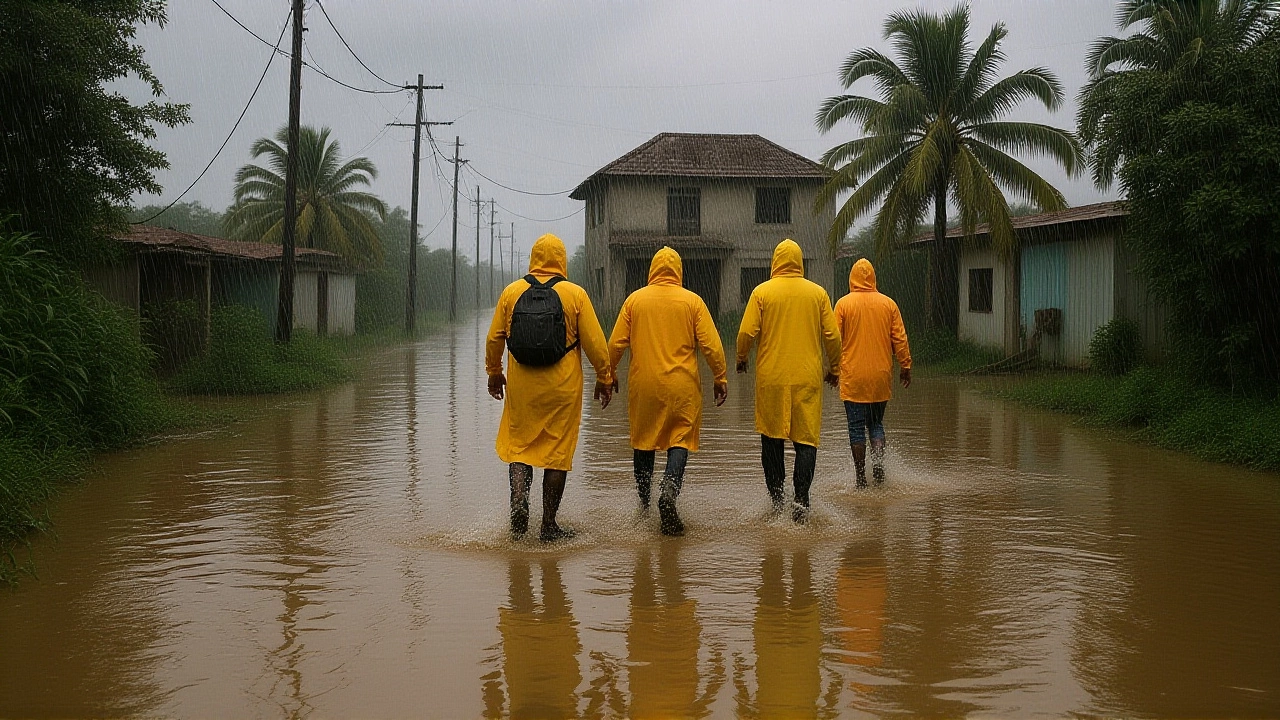A Category 5 hurricane named Hurricane Melissa tore through Jamaica with terrifying force, leaving behind a landscape of shattered homes, flooded streets, and isolated communities—just days before the storm turned its gaze toward the Bahamas. The destruction, captured in a NBC News video published on October 29, 2025, was described in stark, unvarnished terms: "homes were torn apart and streets were inundated with water." The storm, labeled a "monster" by reporters, had already made landfall in Cuba after ravaging Jamaica, confirming a deadly path across the Caribbean. As of that date, emergency crews still couldn’t reach some of the hardest-hit areas, raising fears of unreported casualties and worsening humanitarian conditions.
What Happened in Jamaica?
The full extent of Hurricane Melissa’s damage in Jamaica remains unclear, but the imagery and language used by NBC News leave little room for understatement. The storm’s Category 5 status—meaning sustained winds of at least 157 mph—would have ripped roofs from buildings, snapped power lines like twigs, and turned rivers into torrents. Coastal towns like Port Antonio and Montego Bay—though unnamed in the report—are likely among the worst affected, given their proximity to the sea and history of vulnerability. The phrase "impossible to reach" suggests landslides, washed-out roads, and downed communication towers. In rural mountain zones, entire villages may have been cut off for days.
There’s no official death toll. No estimate of economic loss. No number of displaced families. That silence speaks volumes. In past storms like Hurricane Gilbert (1988) or Hurricane Ivan (2004), it took weeks to tally the full cost. What we know now is the raw, immediate aftermath: water up to second-story windows, cars tossed like toys, and the eerie quiet of neighborhoods where power and phone signals vanished.
The Reporter on the Ground
George Solis, a seasoned NBC News field reporter, was stationed in the Bahamas as the storm approached. His presence there wasn’t coincidental—it was strategic. With Hurricane Melissa having already struck Jamaica and Cuba, NBC News was positioning its team ahead of the next impact zone. Solis’s reporting—though not yet aired in full—likely included interviews with Bahamian officials, emergency responders, and residents preparing for evacuation. His reporting from the Bahamas offered a chilling preview: what happened in Jamaica could soon be replicated elsewhere.
It’s worth noting that Solis wasn’t in Jamaica. That absence is telling. Newsrooms often deploy reporters to the next anticipated disaster zone rather than the one just hit—because the story is still unfolding. The footage from Jamaica came from local journalists, drones, or satellite imagery, filtered through NBC News’s editorial team. The human element, the faces behind the devastation, were still waiting to be told.
A Pattern of Escalation
Hurricane Melissa didn’t come out of nowhere. The 2025 Atlantic hurricane season had already seen above-average activity, with sea surface temperatures in the Caribbean hitting record highs—nearly 1.5°C above the 30-year average. Scientists at the National Hurricane Center had warned for weeks that conditions favored rapid intensification. Melissa went from tropical storm to Category 5 in under 36 hours—a trend seen more often in recent years.
Compare this to Hurricane Maria in 2017, which killed over 3,000 people in Puerto Rico and left the island without power for months. Jamaica’s infrastructure, though more resilient than Puerto Rico’s in some ways, still relies heavily on aging power grids and poorly maintained roads. When a storm like Melissa hits, it doesn’t just damage—it exposes.
What Comes Next?
As Hurricane Melissa closed in on the Bahamas, officials there scrambled. Emergency shelters opened in Nassau. The military was put on standby. But for those in the outer islands—Andros, Eleuthera, Abaco—the clock was ticking. The storm’s path was unpredictable. One model suggested a direct hit; another, a glancing blow. Either way, the damage in Jamaica was a warning.
Recovery in Jamaica will take years. Insurance coverage is sparse. Many homes are built without permits, meaning they won’t qualify for federal aid. International aid is slow to arrive without clear casualty numbers. And with another storm season just beginning, the window for rebuilding is narrow.
Why This Matters
This isn’t just about Jamaica. Or Cuba. Or the Bahamas. It’s about what happens when climate change and poor infrastructure collide. The Caribbean has long been on the front lines of extreme weather. But in 2025, the storms aren’t just stronger—they’re more frequent, more unpredictable, and more devastating. The world watches when a hurricane hits Florida or Texas. But when it hits Kingston or Santiago de Cuba, the world often looks away.
That needs to change. The people of Jamaica didn’t cause this crisis. But they’re paying the price for it.
Frequently Asked Questions
How strong was Hurricane Melissa compared to past storms in the Caribbean?
Hurricane Melissa was a Category 5 storm, the highest possible rating on the Saffir-Simpson scale, with winds exceeding 157 mph. Only five Category 5 hurricanes have made direct landfall in Jamaica since 1950, including Hurricane Gilbert in 1988 and Hurricane Allen in 1980. Melissa’s rapid intensification—reaching peak strength in under 36 hours—matches the trend seen in recent decades, linked to warmer ocean temperatures. Its intensity places it among the top 10 strongest Atlantic hurricanes on record.
Why couldn’t emergency teams reach some areas in Jamaica?
Landslides triggered by torrential rains buried roads in mountainous regions like the Blue Mountains and Cockpit Country. Bridges collapsed, power lines fell across highways, and floodwaters submerged key arteries like the A1 and A2 highways. Communication towers were destroyed, cutting off GPS and radio signals. Helicopters were grounded due to high winds, and ground teams lacked fuel or safe routes. Some villages may have been isolated for over a week.
What role did climate change play in Hurricane Melissa’s intensity?
Scientists from the National Oceanic and Atmospheric Administration confirmed that sea surface temperatures in the Caribbean were 1.3–1.8°C above average during Melissa’s formation. This extra heat provided more energy for rapid intensification. Studies show that storms like Melissa are now 30% more likely to reach Category 5 strength than they were in the 1980s. While no single storm is caused by climate change, the odds of catastrophic hurricanes are rising sharply.
Is there any help coming to Jamaica?
The Jamaican government declared a state of emergency and requested international aid. The United Nations, the Red Cross, and the Caribbean Disaster Emergency Management Agency (CDEMA) have pledged logistical support, including water purification units and mobile medical teams. The U.S. Agency for International Development (USAID) has dispatched a team to assess damage. But aid delivery depends on restored access—something that could take days or weeks. Local NGOs are already distributing supplies, but demand far outstrips supply.
What’s the next threat after the Bahamas?
After passing the Bahamas, Hurricane Melissa was forecast to move northward, potentially threatening Florida’s east coast by November 3. However, models diverged on whether it would make landfall or curve out to sea. The National Hurricane Center warned that even a near-miss could bring torrential rain and dangerous surf from the Carolinas to the Florida Panhandle. Residents in those areas were advised to prepare for power outages and flooding.
Why wasn’t more information released about casualties or damage?
In the immediate aftermath of a Category 5 storm, communication networks collapse, and emergency responders prioritize life-saving efforts over data collection. Official figures often take days or weeks to emerge. In Jamaica, where many rural areas lack digital infrastructure, reporting delays are common. NBC News and other outlets rely on verified visuals and eyewitness accounts before publishing numbers. Until helicopters or ground teams reach isolated zones, casualty counts remain estimates.






